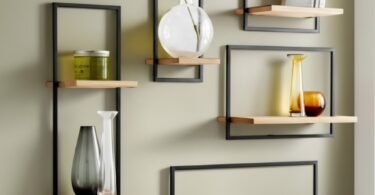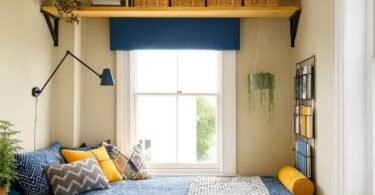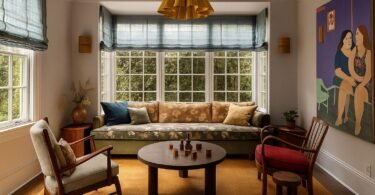Let me tell you something that nobody warned me about when I became a parent. Buying furniture for your kid’s room feels like trying to solve a Rubik’s cube blindfolded. You walk into a store or start scrolling online, and suddenly you’re staring at what feels like a million different options. Beds shaped like race cars, cribs that promise to grow with your baby, dressers in every color imaginable. My head was spinning the first time I tried to furnish my daughter’s room.
What really gets me is that not every piece of furniture out there actually puts safety first. Some companies seem more interested in making things look cute than making them safe. I’ve seen wobbly dressers, beds with sharp corners that could easily hurt a kid, and cribs with slats spaced too far apart. When you’re shopping for your child’s room, you can’t just grab whatever looks nice and call it a day.
The thing about kids is they don’t come with an instruction manual. Neither does their furniture, or at least not a good one most of the time. You’re left trying to figure out what will keep them safe while they’re playing, sleeping, and doing all those wild things kids do when you’re not looking. I once watched my son use his dresser as a climbing wall. That’s when I realized that “safe enough” isn’t actually safe enough.
Safety comes first, second, and third when we’re talking about where your kids sleep and play. You need furniture that won’t tip over when they inevitably try to climb it. You need corners that won’t send you rushing to the emergency room. You need materials that aren’t going to off gas weird chemicals into the air your baby breathes all night long.
Here’s what I’ve learned after furnishing rooms for three kids. The prettiest option isn’t always the best option. That fancy white dresser might look amazing on Instagram, but can it handle a toddler who thinks drawers are steps? Will it still look good after your kid decides to practice their art skills on it with permanent marker? These are the questions that keep parents up at night, right alongside wondering if we remembered to pack snacks for tomorrow.
Price tags can be deceiving too. I’ve bought cheap furniture that fell apart within a year, and I’ve bought expensive furniture that my kids outgrew before it showed any wear. Finding that sweet spot between quality and value takes some work. You want pieces that will last, but you don’t want to take out a second mortgage just to buy a bed.
Think about it this way. Your kid’s bedroom is where they’ll spend roughly half their childhood. They’ll learn to sleep through the night there, have sleepovers with friends there, hide from you when they’re in trouble there. That room needs furniture that supports all of those moments. It needs to be a space where they feel safe and happy, not a space where you’re constantly worried about what might go wrong.

Finding the Right Fit for Every Age
Kids grow up way too fast. One minute you’re bringing home a newborn who fits in the crook of your arm, and the next minute they’re asking to redecorate their room for the fifth time. The furniture you choose needs to keep up with these changes, or you’ll find yourself shopping for new pieces every couple of years.
When my oldest was three, she was perfectly happy with her toddler bed that had little rails on the sides. By the time she turned five, she was begging for a “big girl bed” like her friend had. Kids develop opinions about their space earlier than you might think. They want to have a say in what their room looks like, and honestly, giving them some control over their environment helps them feel more confident.
Storage becomes a bigger deal as kids get older. Babies need places to keep diapers and onesies. Toddlers need spots for their growing collection of toys. School age kids need room for books, art supplies, clothes they actually care about, and all the random treasures they collect. I found a rock collection in my son’s dresser last week. Not in a box. Just loose rocks rolling around in his sock drawer.
The layout of the room matters more than I first realized. You can’t just shove a bed against one wall and call it done. Kids need space to move around and play. They need their bed positioned where they can see the door because a surprising number of kids worry about not being able to see who’s coming in. They need their clothes within reach once they start dressing themselves, unless you enjoy picking out their outfits every single morning until they leave for college.
Older kids want furniture that reflects who they are or who they think they are. My daughter went through a phase where everything had to be purple. Then it was horses. Then it was some band I’d never heard of. If you buy furniture that’s too specific to one interest, you’ll be replacing it the second they move on to the next obsession. Neutral pieces that can be personalized with bedding, posters, and accessories work better for the long haul.
Some kids are rough on their stuff. They jump on beds, slam drawers, and treat their furniture like playground equipment. Other kids are surprisingly gentle and careful. You know your child better than anyone, so think about their personality when you’re shopping. A kid who likes to climb needs a sturdy bed frame that can handle the extra activity. A kid who’s more mellow can probably handle something a bit more delicate.
The height of furniture makes a big difference for younger kids. Can they reach their clothes? Can they climb into bed safely? Can they access their toys without needing help every five minutes? Independence is huge for kids. When they can do things themselves, they feel proud and capable. When they have to ask for help with everything, they get frustrated. We had a dresser that was too tall for my son to reach the top drawers. Guess what? He never put his clothes in those drawers. He just piled everything on the floor instead.

Smart Storage Solutions That Actually Work
I’ll be honest with you. I used to think storage was boring. Then I had kids, and I realized that good storage is basically magic. It’s the difference between a room that looks like a tornado hit it and a room where you can actually see the floor. Under bed storage changed my life. I’m not being dramatic. It really did.
Those drawers that slide out from under the bed are perfect for storing things your kids don’t use every day but still need access to. Winter clothes during summer, board games, extra blankets, toys they’ve kind of outgrown but aren’t ready to part with yet. My kids have this attachment to stuffed animals that borders on obsessive. We have approximately 847 stuffed animals, according to my last count. Most of them live in bins under the bed now.
Containers and bins only work if you actually use them. I bought a bunch of cute labeled bins thinking I’d solved all our organization problems. Then I realized my kids couldn’t read yet, so the labels meant nothing to them. Pictures work better for younger kids. A bin with a picture of Legos on it makes sense to a five year old. A bin labeled “Building Toys” just looks like random letters.
The key is making storage accessible. If putting toys away is too complicated, kids won’t do it. If they have to ask for help every time they want to get something out or put something away, they’ll stop bothering. We set up a low bookshelf in my daughter’s room where she could reach everything herself. Cleanup time became so much easier because she could actually do it without me hovering over her.
Closet organization deserves its own paragraph because closets are wasted space in most kids’ rooms. The standard closet setup with one high bar doesn’t work for children. They can’t reach it. Lower bars, cubbies, and shelves make closets actually functional. We added a second bar at my son’s height, and suddenly he started hanging up his own clothes. Miracles do happen.
You’d be surprised how much stuff accumulates in a kid’s room. School papers, art projects, birthday party favors, random freebies from restaurants. If you don’t have a system for dealing with this influx, it takes over. A small filing box for important school stuff helps. A bin for art projects that you’ll “definitely display later” helps. A trash can that your kid can actually use helps most of all.
Think vertical when you’re planning storage. Wall mounted shelves, hanging organizers, hooks on the back of doors. Floor space is limited, but wall space usually isn’t. My kids have hooks for their backpacks, jackets, and the random hats they insist on collecting. Everything has a place, which means everything can get put back. In theory. The reality is a bit messier, but we’re working on it.
Why Convertible Cribs Make Sense
Babies are expensive. Let me repeat that for the people in the back. Babies are expensive. You need diapers, formula or nursing supplies, clothes they’ll outgrow in three weeks, and furniture that costs more than your first car. When I found out about convertible cribs, I felt like someone had let me in on a secret that should’ve been shared way earlier.
A convertible crib starts as a standard crib for your newborn. Then, when your baby becomes a toddler, you can convert it into a toddler bed. Some models go even further and turn into daybeds or full sized beds. You’re buying one piece of furniture that lasts for years instead of buying a new bed every time your kid hits a growth spurt.
The quality of convertible cribs tends to be better than regular cribs. Manufacturers know these pieces need to last through multiple stages, so they build them more sturdy. The wood is thicker. The hardware is stronger. The construction is more solid. I’ve seen convertible cribs that have been through three kids and still look great.
Cost wise, convertible cribs make financial sense if you plan to use them through all the stages. A decent convertible crib might cost more upfront than a basic crib, but you save money in the long run by not buying a toddler bed, then a twin bed, then a full bed. Do the math. It adds up quickly, and not in a good way if you’re buying separate pieces.
Some parents worry that convertible cribs are too trendy or that they won’t actually use all the conversion options. I get that concern. But here’s the thing. Even if you only convert it once, from crib to toddler bed, you’re still getting more use out of it than a standard crib. And if you have more than one kid, that crib can start over with the next baby before converting again.
The conversion process is usually straightforward. You remove the front rail and replace it with a shorter rail for the toddler bed stage. Later, you might remove all the rails for a daybed. The instructions are generally clear, and you don’t need to be a carpenter to figure it out. I managed to convert my daughter’s crib while watching a toddler and talking on the phone. If I can do it, anyone can.
Style matters when you’re picking a convertible crib. You want something that will still look good when it’s a full sized bed in a ten year old’s room. Trendy designs might seem appealing now, but will your teenager want to sleep in a bed that’s covered in baby decorations? Probably not. Stick with classic styles in neutral colors. You can always add personality with bedding and accessories.

Knowing When to Make the Switch
Here’s a fun parenting moment nobody tells you about. You’ll walk past your kid’s room one night and catch them trying to climb out of their crib. Your heart will stop for a second. Then you’ll realize it’s time for a big kid bed. The timing is different for every child, but there are signs that make it pretty obvious.
Most kids start trying to escape their cribs between 18 months and three years old. Some are early escape artists. Others are content to stay put longer. My son tried to climb out at 20 months. My daughter waited until she was almost three. There’s no right or wrong timeline. You just have to pay attention to what your kid is doing.
Safety becomes the main concern when climbing starts. A toddler who can get out of their crib can get out while you’re sleeping. They can wander around the house unsupervised. They can get into things they shouldn’t. Moving to a toddler bed feels scary because suddenly they have freedom, but it’s actually safer than having them risk a fall from the crib.
Some parents switch to a bed when another baby is on the way and they need the crib. This can work, but timing matters. You don’t want your older child to feel like they’re being kicked out of their crib for the new baby. Make the transition a few months before the baby arrives if possible. Frame it as a positive step toward being a big kid, not as making room for someone else.
Height is another factor. If your child’s chest is at the top of the crib rail or higher, they’re tall enough to potentially tumble over. Even if they’re not trying to climb out, an accidental flip over the side becomes more likely. We switched my tall son to a bed earlier than we’d planned because he was just getting too big for the crib.
Your child might tell you they’re ready. Some kids see big kid beds at friends’ houses or on TV shows and decide they want one too. If your child is asking for a bed and seems excited about it, that’s a good sign they’re ready. You know your kid. You can tell if they’re mature enough to handle the freedom that comes with a bed.
The actual transition can be rough. Some kids adjust immediately and love their new bed. Others spend weeks getting up repeatedly at night because they can. We used a small nightlight and a consistent bedtime routine to help our kids feel secure in their new sleeping situation. It took a few weeks, but they got there.

Safety Standards You Can’t Ignore
Baby furniture safety regulations exist for good reasons. Too many kids have been hurt or worse by unsafe cribs and beds. I don’t want to scare you, but I do want you to take this seriously. Check that any crib you buy meets current safety standards. The rules change as we learn more about what keeps babies safe.
Slat spacing is one of the big safety concerns. The gaps between crib slats need to be narrow enough that a baby’s head can’t fit through. If a baby can get their head stuck, the results can be tragic. Modern cribs meet these requirements, but if you’re considering a hand me down or vintage crib, measure those slats carefully.
The mattress fit matters more than people realize. There shouldn’t be gaps between the mattress and the crib frame. A baby can get wedged into those gaps. I’ve checked mattress fit by trying to squeeze more than two fingers between the mattress and the frame. If you can fit more than that, the mattress is too small or the crib is too big.
Corner posts and decorative cutouts can be dangerous. Babies and toddlers can catch their clothing on posts that extend above the end panels. Cutouts in the headboard or footboard can trap tiny heads or limbs. The safest cribs are simple and solid without a lot of decorative details that create hazards.
Drop side cribs were popular years ago but are now banned. The drop side mechanism can fail, creating a gap where a baby can get trapped. If someone offers you a drop side crib, even a nice expensive one, say no. It’s not worth the risk no matter how much money it saves you.
Paint and finishes need to be non toxic. Babies chew on everything, including their cribs. Lead paint is obviously dangerous, but other chemicals can be problems too. Look for cribs with finishes that are labeled as baby safe. Natural wood finishes or water based paints are good options.
Hardware should be checked regularly. Screws can loosen over time, especially on furniture that gets converted from one form to another. I got in the habit of checking all the bolts and screws on my kids’ beds once a month. It takes five minutes and could prevent a dangerous situation.
Recalls happen. Even major brands have recalls sometimes. Register your crib with the manufacturer so you’ll be notified if there’s ever a safety issue. Check the Consumer Product Safety Commission website before buying used furniture. A crib that seems like a great deal might have been recalled for safety reasons.
Getting the Most from Your Investment
Let me wrap this up with some real talk about making smart furniture choices. You don’t need to buy the most expensive option to get quality. You do need to do your research and think about how you’ll actually use the furniture. I’ve made plenty of mistakes over the years, and I’ve learned what works and what doesn’t.
Read reviews from actual parents, not just the marketing copy on the website. Parents will tell you if the drawers stick, if the paint chips easily, if the bed frame is noisy. They’ll mention things the manufacturer never would, like how hard the furniture is to assemble or whether it arrived damaged.
Buy from retailers with good return policies. Sometimes furniture looks great online but disappointing in person. Sometimes it doesn’t fit in the room the way you expected. Being able to return or exchange pieces without jumping through hoops makes the whole process less stressful.
Measure everything before you buy. I mean everything. The room, the doorways, the space around where the furniture will go. I once bought a beautiful dresser that wouldn’t fit through my daughter’s bedroom door. We had to return it and start over. Learn from my mistake. Measure twice, buy once.
Think about how the furniture will grow with your child. Pieces that work for multiple stages are worth the investment. A dresser is a dresser whether your kid is two or twelve. A bed that converts from toddler to full size will be useful for years. Furniture that’s too babyish will need replacing sooner than you’d like.
Don’t forget about assembly. Some furniture comes fully assembled. Some requires hours of work with tiny screws and confusing instructions. If you’re not handy or don’t have time, factor in the cost of assembly services. Your sanity is worth the extra money.
Match your furniture choices to your real life. If you have pets who shed, maybe skip the white upholstered headboard. If your kids are messy, that trendy light colored wood might not be practical. Be honest about your household and choose accordingly.
The bottom line is this. Kids’ bedroom furniture is a bigger decision than it seems like it should be. You’re balancing safety, budget, style, and practicality. You’re trying to create a space where your child will feel comfortable and happy. Take your time with these choices. Ask questions. Trust your instincts. You know what your family needs better than any salesperson or website ever could.








Leave a Comment